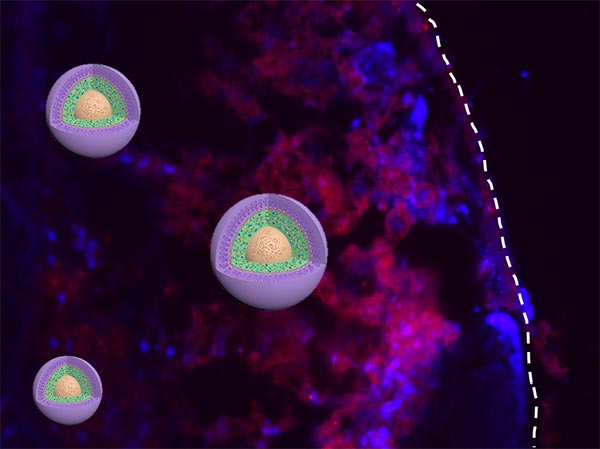Study reveals optimal particle size for anticancer nanomedicines

The nanomedicine (red) with the optimal size shows the highest tumor tissue (blue) retention integrated over time, which is the collective outcome of deep tumor tissue penetration, efficient cancer cell internalization as well as slow tumor clearance.
“To develop next generation nanomedicines with superior anti-cancer attributes, we must understand the correlation between their physicochemical properties—specifically, particle size—and their interactions with biological systems,” explains Jianjun Cheng, an associate professor of materials science and engineering at the University of Illinois at Urbana-Champaign.
In a recent study, published in the Proceedings of the National Academy of Sciences, Cheng and his collaborators systematically evaluated the size-dependent biological profiles of three monodisperse drug-silica nanoconjugates at 20, 50 and 200 nm. “There has been a major push recently in the field to miniaturize nanoparticle size using novel chemistry and engineering design,” Cheng added.
“While most current approved anti-cancer nanomedicines’ sizes range from 100-200 nm, recent studies showed that anti-cancer nanomedicines with smaller sizes—specifically of 50 nm or smaller—exhibited enhanced performance in vivo, such as greater tissue penetration and enhanced tumor inhibition.”
“Over the last 2-3 decades, consensus has been reached that particle size plays a pivotal role in determining their biodistribution, tumor penetration, cellular internalization, clearance from blood plasma and tissues, as well as excretion from the body—all of which impact the overall therapeutic efficacy against cancers,” stated Li Tang, first author of this PNAS article.
“Our studies show clear evidence that there is an optimal particle size for anti-cancer nanomedicines, resulting in the highest tumor retention. Among the three nanoconjugates investigated, the 50 nm particle size provided the optimal combination of deep tumor tissue penetration, efficient cancer cell internalization, as well as slow tumor clearance, exhibits the highest efficacy against both primary and metastatic tumors in vivo.
Jianjun ChengTo further develop insight into the size dependency of nanomedicines in tumor accumulation and retention, the researchers developed a mathematical model of the spatio-temporal distribution of nanoparticles within a spherically symmetric tumor. The results are extremely important to guide the future research in designing new nanomedicines for cancer treatment, Cheng noted.
In addition, a new nanomedicine developed by the Illinois researchers—with precisely engineered size at the optimal size range—effectively inhibited a human breast cancer and prevented metastasis in animals, showing promise for the treatment of a variety of cancers in humans. Cheng, a Willett Faculty Scholar at Illinois, is affiliated with the departments of Bioengineering and of Chemistry, the Beckman Institute for Advanced Science and Technology, the Micro and Nanotechnology Laboratory, the Institute of Genomic Biology, the Frederick Seitz Materials Research Laboratory, and University of Illinois Cancer Center.
Tang, who obtained his PhD degree from the University of Illinois with Jianjun Cheng, is currently a CRI Irvington postdoctoral fellow at the Massachusetts Institute of Technology. Collaborators and co-corresponding authors of the paper at Illinois include Timothy Fan, associate professor, veterinary clinical medicine; Andrew Ferguson, assistant professor, materials science and engineering; and William Helferich, professor, food science and human nutrition. The paper, “Investigating the optimal size of anticancer nanomedicine,” can be found online.
Contact:
Jianjun Cheng, Department of Materials Science and Engineering,
University of Illinois at Urbana-Champaign, 217-244-3924
Media Contact
More Information:
http://engineering.illinois.edu/news/article/9546All latest news from the category: Health and Medicine
This subject area encompasses research and studies in the field of human medicine.
Among the wide-ranging list of topics covered here are anesthesiology, anatomy, surgery, human genetics, hygiene and environmental medicine, internal medicine, neurology, pharmacology, physiology, urology and dental medicine.
Newest articles

High-energy-density aqueous battery based on halogen multi-electron transfer
Traditional non-aqueous lithium-ion batteries have a high energy density, but their safety is compromised due to the flammable organic electrolytes they utilize. Aqueous batteries use water as the solvent for…

First-ever combined heart pump and pig kidney transplant
…gives new hope to patient with terminal illness. Surgeons at NYU Langone Health performed the first-ever combined mechanical heart pump and gene-edited pig kidney transplant surgery in a 54-year-old woman…

Biophysics: Testing how well biomarkers work
LMU researchers have developed a method to determine how reliably target proteins can be labeled using super-resolution fluorescence microscopy. Modern microscopy techniques make it possible to examine the inner workings…





















